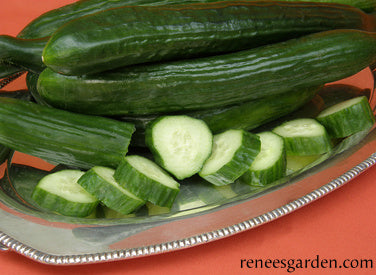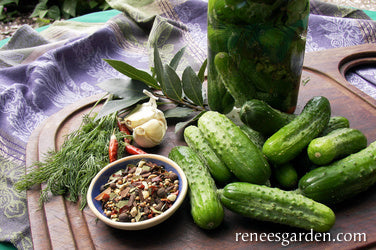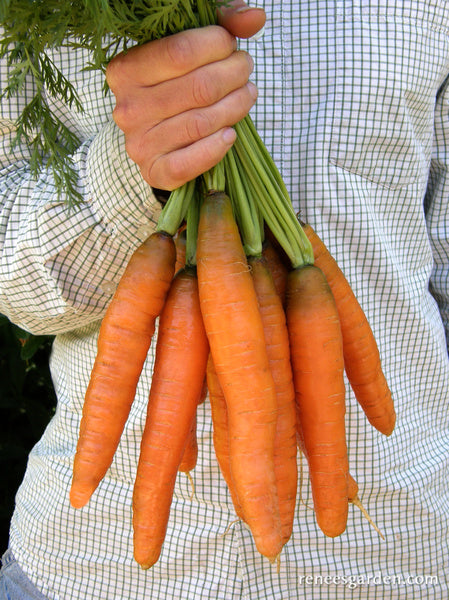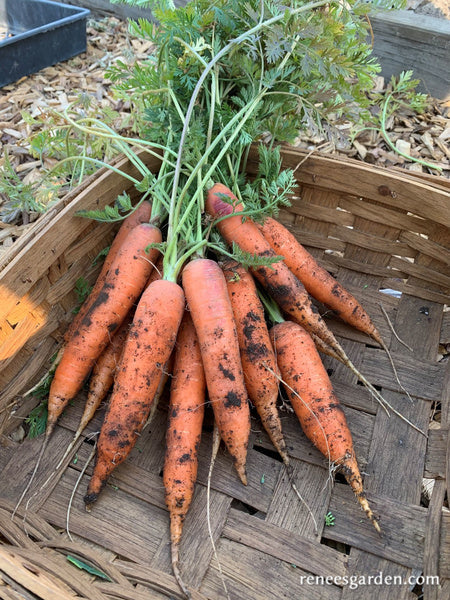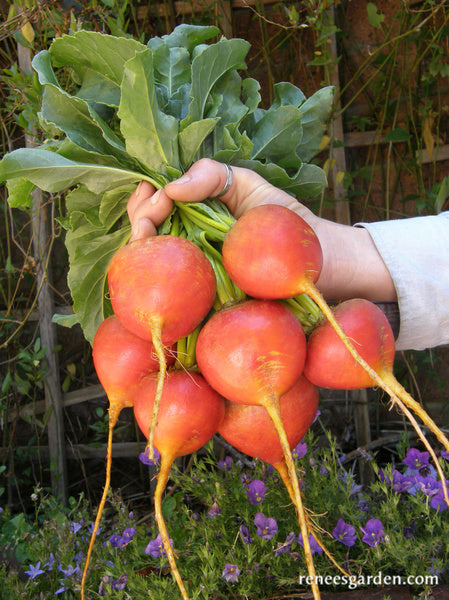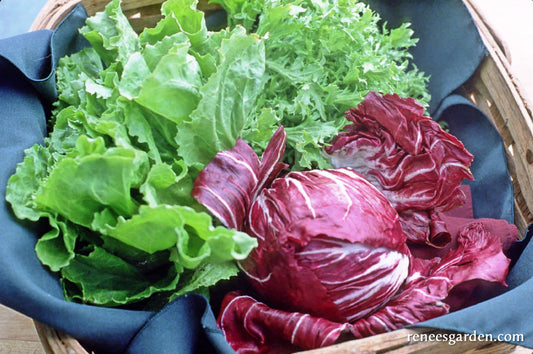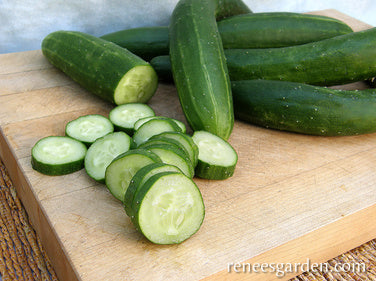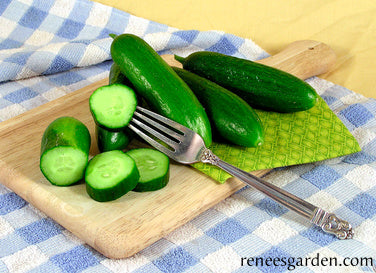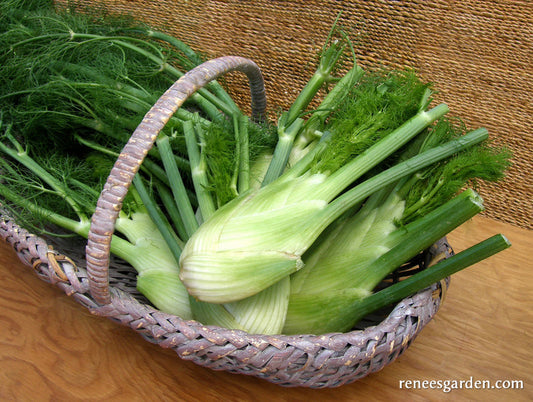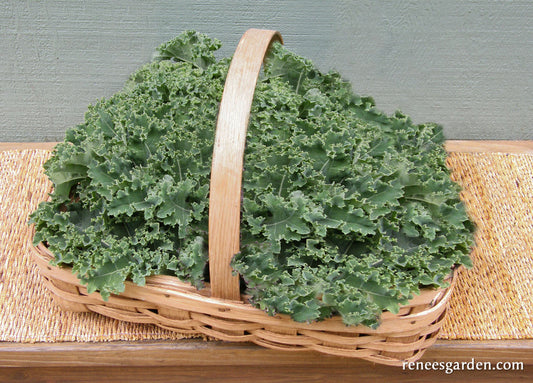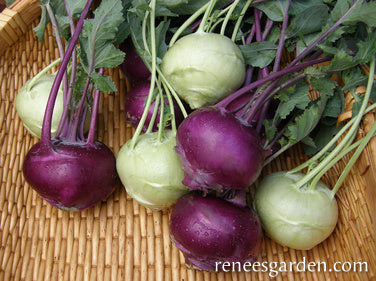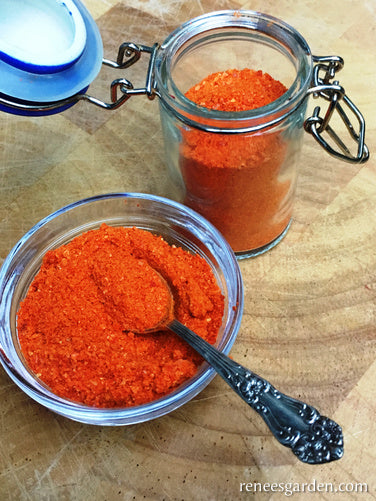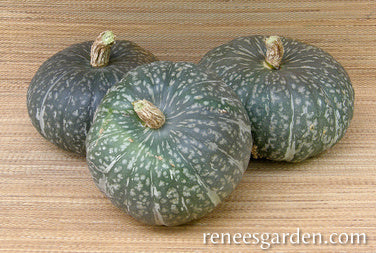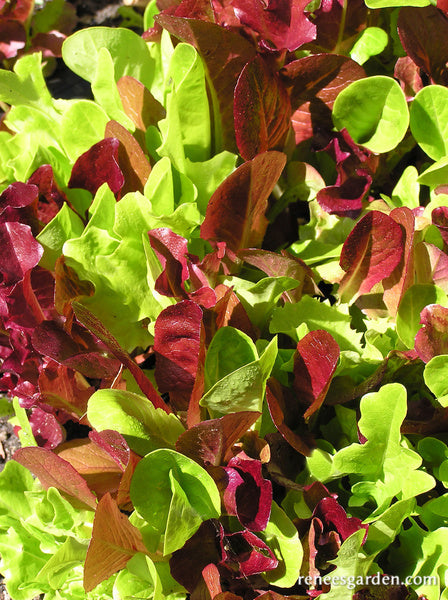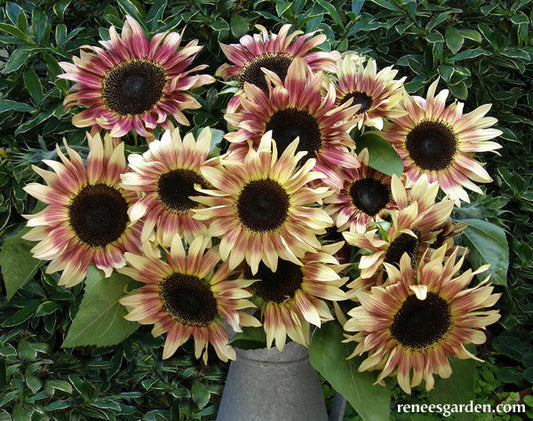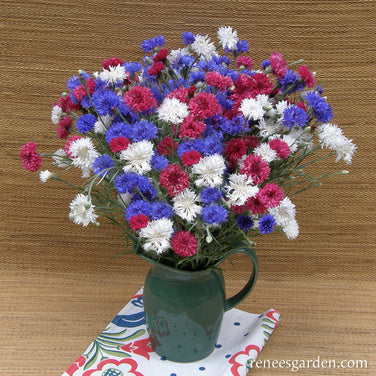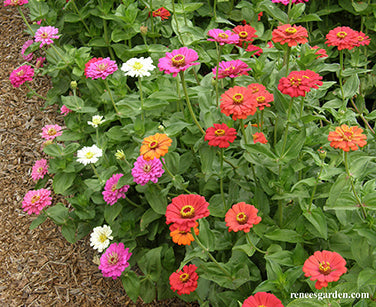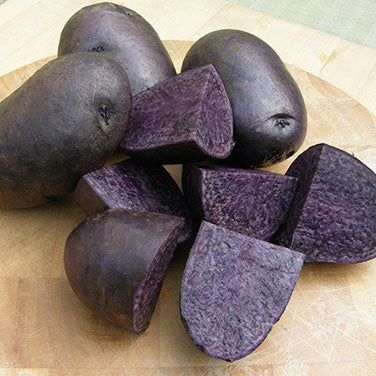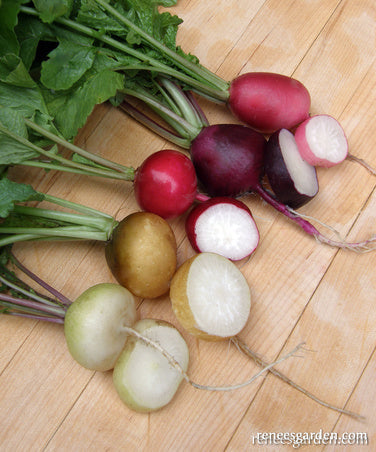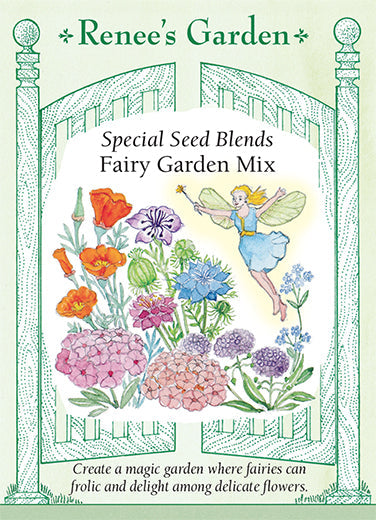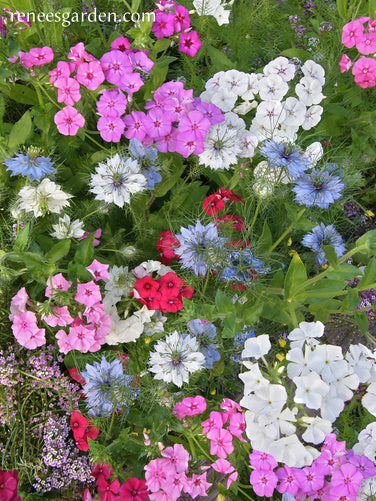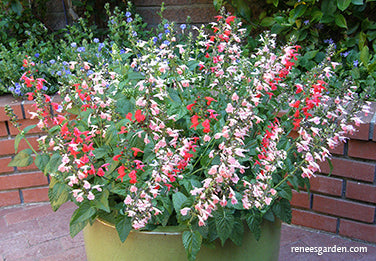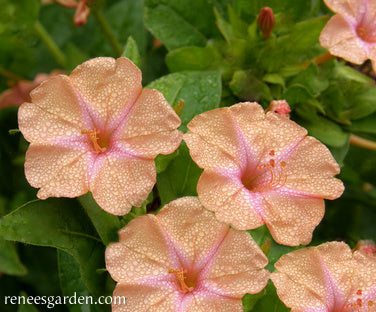All
-
English Cucumber Chelsea Prize
START SEEDS OUTDOORS
Plant heat loving cucumbers only when weather is warm and settled and night temperatures stay above 50°F (13°C). Amend soil well with aged manure or compost. Sow groups of 2 to 3 seeds 1 1/2 feet apart and 1 inch deep with 3 feet between rows. Thin to 1 seedling per group. Or make slightly mounded hills 5 feet apart, sowing 5 or 6 seeds in each hill. Thin to the 3 strongest plants.
GROWING NOTES
Protect seedlings from marauding birds with plastic berry baskets, removing before plants get crowded. Shallow rooted cucumbers need ample and consistent moisture. Avoid overly wet or dry periods for good quality fruit. Growing cucumber vines up vertical supports gives you long straight fruits and saves garden space.
HARVEST AND USE
Cut rather than pull fruits from vines before seeds are large inside. Harvest every few days for longest fruit production. These juicy tender cucumbers need no peeling. Slice and enjoy for refreshing snacks, in salads and sandwiches. Eat cucumbers within a day or two of picking for best taste and quality.
Regular price $4.99Sale price $4.99Unit price / per -
Pickling Cucumber Endeavor
START SEEDS OUTDOORS
Plant heat loving cucumbers only when weather is warm and settled and night temperatures stay above 50°F (10°C). Amend soil well with aged manure or compost. Sow groups of 2 to 3 seeds 1 1/2 feet apart and 1 inch deep with 3 feet between rows.
Thin to 1 seedling per group. Or make slightly mounded hills 5 feet apart, sowing 5 or 6 seeds in each hill. Thin to the 3 strongest plants.
GROWING NOTES
Protect seedlings from marauding birds with plastic berry baskets, removing before plants get crowded. Shallow rooted cucumbers need ample and consistent moisture. Avoid overly wet or dry periods for good quality fruit. Growing cucumber vines up vertical supports gives you long straight fruits, saves garden space and makes them easy to harvest.
HARVEST AND USE
Cut rather than pull fruits from vines when 3 to 4 inches long. Harvest often: every few days for longest fruit production and so cucumbers don’t get too big on the vine. Try to put up pickles very soon after harvesting for best results. Enjoy some Endeavor cucumbers fresh picked from the garden, sliced up with tomatoes and chopped dill or chives with olive oil and a pinch of salt.
Regular price $3.69Sale price $3.69Unit price / per -
Nantes Carrots Yaya
START SEEDS OUTDOORS
In spring once danger of hard frost is past, sow seeds in full sun in finely worked, fertile soil. Sow 1/4 inch deep and 1/2 inch apart in rows 8 inches apart, or broadcast thinly in beds and cover lightly. Keep seedbed evenly moist as carrots can be slow to germinate, emerging over 10 to 20 days. If first sowing comes up unevenly, replant right away as seedlings catch up quickly. Be sure to thin young carrots several times so seedlings are about 2 inches apart and have room to size up.
GROWING NOTES
Carrots like well-worked soil and need consistent moisture to grow well. If your soil tends to dry out, cover seedbed with floating row cover or burlap to help retain moisture during the germination period and water right through it. Keep carrots well watered and thinned. For a late season crop, sow again 3 months before first expected frost.
HARVEST AND USE
Let young carrots size up and color fully to orange before harvesting for best flavor. Sauté or steam just until tender crisp and serve with a squeeze of fresh lemon or lime juice, sweet butter and fresh dill; or try buttered and glazed with a little maple syrup or honey.
Regular price $4.89Sale price $4.89Unit price / per -
Crispy French Carrots Bolero Nantes
START SEEDS OUTDOORS
In spring once danger of hard frost is past, sow seeds in full sun in finely-worked, fertile soil. Sow 1/4 inch deep and 1/2 inch apart in rows 8 inches apart, or broadcast thinly in beds and cover lightly. Keep seed bed evenly moist as carrots can be slow to germinate, emerging over 10 to 21 days. If first sowing comes up unevenly, replant right away as seedlings catch up quickly. Thin young carrots several times so seedlings are 2 to 3 inches apart and have room to size up.
GROWING NOTES
Carrots like well-worked soil and need consistent moisture to grow well. If your soil dries out fast, cover seedbed with floating row covers to help retain moisture during the germination period. Keep carrots well weeded throughout the growing season. Plant again 3 months before first expected fall frost for a late crop.
HARVEST AND USE
Let carrots color up to deep orange before harvesting for best sweet flavor. Eat fresh, juice, or lightly steam. Set off their flavor with fresh lemon or orange juice and a sprinkling of minced herbs. Or glaze with a little honey and ginger or cinnamon. Fresh mint leaves are a tasty, pretty garnish for fresh garden carrots.
Regular price $3.99Sale price $3.99Unit price / per -
Gourmet Beets Golden
START SEEDS DIRECTLY OUTDOORS
In early spring, when danger of hard frost is over, sow seeds in well-worked, fertile soil in full sun. Space seeds 1 inch apart in rows 8 to 10 inches apart, or broadcast evenly for bed planting. Firming soil well over these irregularly shaped seeds will ensure best germination. If first sowing comes up unevenly, sow more seeds as seedlings will catch up fast. When large enough, carefully thin seedlings to 3 to 4 inches apart so growing beets have room to size up.
GROWING NOTES
For best quality, tender roots, sow seeds before midsummer heat and again in late summer to early fall—in cold climates, allow at least 10 weeks before fall frosts. Keep soil evenly moist throughout the season. Be sure to thin seedlings several times when plants are small, as beets grow best if given enough room.
HARVEST AND USE
After thinning seedlings, use tender young tops for nutritious, flavorful steamed greens. Harvest baby beets at 1 to 2 inches in diameter, or let roots grow as large as desired. Garden fresh beets cook quickly. They are delicious steamed, boiled or baked whole in their skins like potatoes, then peeled for wonderful color and sweet concentrated flavor. Golden color does not “bleed” like red beets.
Regular price $3.99Sale price $3.99Unit price / per -
Signature Salads Crispy Winter Greens
START SEEDS OUTDOORS
At midsummer, or early fall in mild climates, sow seeds in a sunny garden bed 1/4 inch deep and 1 to 2 inches apart in rows 12 inches apart. Or, if it is still over 80°F (27°C) at sowing time, sow seeds in containers in a spot out of direct sun, but with bright light all day. Tend carefully and keep evenly moist. When seedlings are a few inches tall with several sets of leaves, transplant into the garden a foot apart. Gradually thin directly sown seedlings to stand 1 foot apart to allow heads room to mature.
GROWING NOTES
Savor earliest thinnings in fall salads. Cool weather will bring vigorous growth. These tasty greens tolerate cold weather and light frosts well but require consistent moisture. Weed, water and thin carefully and feed monthly for best quality salad heads.
HARVEST AND USE
Radicchio is best harvested when red heads have formed inside the outer green “wrapper” leaves. Pick entire heavy rosettes of escarole and curly endive. Cut up and enjoy these hearty salads with either simple vinaigrettes or rich, creamy dressings. Try tossed with cooked chicken, meat or cubed cheese and olives for delicious whole meal salads. Add toasted nuts and cubed apples or pears for a delicious flavor contrast.
Regular price $3.69Sale price $3.69Unit price / per -
Japanese Cucumber Tasty Green
START SEEDS OUTDOORS
Plant heat-loving cucumbers in full sun only after spring weather is warm and settled and night temps stay above 50°F (10°C). Amend soil well with aged manure or compost. Sow in groups of 2 to 3 seeds 18 in. apart and 1 in. deep. When the baby seedlings are 2 in. tall, thin out extras, leaving one strong seedling per group.
After thinning, put 4-5 ft. strong vertical supports or individual tomato cages around each seedling and train vines up supports as they grow. This approach makes it easier to harvest straight fruits, saves garden space, and helps prevent disease.
GROWING NOTES
Protect seedlings from marauding birds with plastic berry baskets, removing before plants get crowded. Shallow-rooted cucumbers need adequate and consistent moisture to produce sweet tasting, nicely formed cucumbers. Avoid overly wet or dry periods for good quality fruits.
HARVEST AND USE
Cut rather than pull fruits from vines before seeds are large inside. Harvest every few days for longest fruit production. These juicy tender cucumbers need no peeling. Slice and enjoy for refreshing snacks, in salads and sandwiches. Eat cucumbers within a day or two of picking for best taste and quality.
Regular price $4.69Sale price $4.69Unit price / per -
Persian Baby Cucumbers Green Fingers
START SEEDS OUTDOORS
Plant heat-loving cucumbers in full sun only when weather is warm and settled and night temps stay above 50°F (10°C), first amending soil well with aged manure or compost. Sow groups of 2 to 3 seeds, 1 inch deep and 18 inches apart. When the baby seedlings are 2 inches tall, thin out extras, leaving one strong seedling per group. After thinning, provide a 3 to 5 foot strong vertical support or tomato cage around each seedling and train the vines up the supports as they grow. Growing vigorous, heavy-bearing cucumber vines up supports makes it easier to harvest the cucumbers, saves garden space, and helps prevent disease.
GROWING NOTES
Protect seedlings from marauding birds with plastic berry baskets, removing before plants get crowded. Shallow-rooted cucumbers need adequate and consistent moisture to produce sweet tasting, nicely formed cucumbers. Avoid overly wet or dry periods for good quality fruits.
HARVEST AND USE
Our baby cucumbers begin bearing fruit early. For best quality, cut rather than pull cucumbers from the vine when 3 to 5 inches long. They need no peeling, just slice and enjoy their crisp texture and flavor. Enjoy in a Mediterranean salad of sliced Green Fingers combined with very fresh plain whole yogurt, a little good olive oil, finely minced garlic and freshly chopped dill.
Regular price $4.99Sale price $4.99Unit price / per -
Heirloom Bulbing Fennel Romanesco
STARTING SEEDLINGS
In early spring when danger of hard frost is over, sow seeds in well-worked, fertile soil in full sun. Space seeds 4 inches apart in rows 12 inches apart and cover seed 1/2 inch deep. Carefully thin when seedlings are large enough to handle to stand 10 to 12 inches apart so bulbs have room to grow and mature. Or start seeds indoors in a container of seed starting mix. Keep moist and provide a strong light source until seedlings are 3 or 4 inches tall and ready to transplant as above.
GROWING NOTES
For tender, best quality bulbs, fennel needs rich soil and cool growing weather, so sow seeds as early as the ground can be worked and again in midsummer for fall harvesting. Be sure seedlings are thinned or transplanted 10 to 12 inches apart. Keep plants evenly moist throughout the growing season – mulching is a good strategy. Fennel is a heavy feeder, so fertilize every 2 to 3 weeks with a high nitrogen fertilizer such as fish emulsion.
HARVEST AND USE
When bulbs are full and plump, cut them off at soil level. Trim the feathery leaves down to the solid base. Slice the crispy bulbs and add to salads, or eat with dips, or grill or sauté. The leafy tops are a great seasoning for seafood, especially salmon. Fennel’s flavor is like sweet anise/ celery that becomes deeper and richer with cooking.
Regular price $4.89Sale price $4.89Unit price / per -
Triple-Curled Kale Dutch Darkibor
TO START DIRECTLY IN THE GARDEN
As soon as ground can be worked in spring, prepare a well-drained, fertile garden bed in full sun. Sow seeds 2 inches apart in rows 12 to 18 inches apart. Cover 1/2 inch deep and keep soil evenly moist to ensure good germination. Sow again in late summer for another cold-hardy crop.
TO START INDOORS
Sow seeds in a container of seed starting mix 2 inches apart and cover 1/2 inch deep. Keep moist and provide a strong light source until seedlings are 3 to 4 inches tall then plant outdoors. Space 10 to 12 inches apart so plants have room to mature.
GROWING NOTES
Kale tastes best in cool weather so sow spring crops early. A crop sown in late summer will yield through fall and winter except in the coldest climates. Frost actually enhances kale leaves’ color, flavor and sweetness. Mulch to retain moisture in summer and before the ground freezes to protect the roots of fall crops.
HARVEST AND USE
Begin harvesting outer leaves when plants have 6 to 8 leaves. Vitamin-rich kale is delicious in hearty winter soups, stews and sautés; or braise the beautiful leaves with garlic and olive oil in traditional Mediterranean style. Pull and discard once plants begin to bloom since the leaves of flowering stalks get tough and bitter.
Regular price $3.99Sale price $3.99Unit price / per -
Gourmet Kohlrabi Crispy Colors Duo
TO START SEEDS DIRECTLY IN THE GARDEN
In early spring, as soon as ground can be worked, plant in well-drained, fertile soil in full sun. Sow seeds 1 inch apart in rows 6 to 8 inches apart. Cover 1/2 inch deep and keep soil evenly moist for good germination. When seedlings are 3 inches tall, thin to stand 4 to 6 inches apart, ensuring that the bulbs have enough room to grow rapidly. Sow again in late summer for another crop.
TO START EARLY INDOORS
Start seeds 4 to 5 weeks before last expected spring frost. Sow 1 inch apart in a container of seed starting mix, cover 1/2 inch deep and keep evenly moist. Provide a strong light source until ready to plant out. When 3 inches tall, transplant seedlings 4 to 6 inches apart into rich, well-drained soil in full sun.
GROWING AND HARVEST
Plant in rich fertile soil. Fertilize regularly and water consistently to ensure the steady growth that produces the best tasting, sweetest kohlrabi. Harvest when bulbs are about 2 to 3 inches in diameter. Peel, slice and enjoy their crisp flesh raw or cook and serve mashed with butter, in soup or with a cream sauce.
Regular price $3.99Sale price $3.99Unit price / per -
Paprika Pepper Hungarian Magyar
STARTING SEEDLINGS
In early spring, start indoors about 6-8 weeks before nights stay reliably 50-55°F (10-13°C). Sow seeds 1/4 inch deep and 1 inch apart in seed starting mix. Keep moist but not soggy, and very warm 80°F (27°C). Provide a strong light source until seedlings are ready to plant outside. When seedlings are 2 inches tall, transplant into 4-inch pots. Keep at 70-75°F (21-24°C). Feed with half-strength fertilizer every week until weather is warm enough to acclimate seedlings to outdoor conditions. Transplant 2 feet apart into rich soil in full sun.
GROWING NOTES
Paprika peppers need warm conditions. Don’t transplant outdoors until nights stay above 55°F (13°C). Prepare soil well with aged manure or compost. Plant only robust seedlings with well-developed roots. Mulch plants to maintain even soil moisture. Keep well weeded, watered and fertilized.
HARVEST AND USE
Cut ripe peppers from the plants when completely red. Slit peppers open, discard seeds and cores and slice in several pieces. Dehydrate pieces until very dry and crisp. Then grind or crush into a coarse spice powder and store in glass jars to use and enjoy liberally. Tightly sealed, home-grown paprika spice powder also freezes well, retaining its wonderful rich flavor.
Regular price $4.39Sale price $4.39Unit price / per -
Kabocha Winter Squash Kurin
BEST TO START OUTDOORS
Long keeping winter squash needs full sun, rich fertile soil and warm temperatures. Wait to plant until nights are comfortably above 50°F (10°C) both day and night. Sow groups of 2 to 3 seeds 2 ft. apart and 1 in. deep in rows 4 ft. apart. Thin to 1 strong seedling per group to give vines room to ramble or climb. Or make slightly mounded hills 2 to 3 ft. across and 6 ft. apart and plant 4 to 5 seeds in each hill. When seedlings have several sets of leaves, thin to the strongest 3 seedlings per hill.
GROWING NOTES
Protect young seedlings from marauding birds by covering with plastic berry baskets at sowing time, removing before plants get crowded. To save space,vines can be trained up fences, trellises or tepees.
HARVEST AND USE
Winter squashes need to mature properly, so don’t harvest until vines have died back and squashes’ exterior rinds are fully dark green and tough enough to resist piercing with a fingernail. Then cut squashes from vines, leaving a good stem handle. Cure in the sun for about 10 days, before storing in a cool dry place where they will keep for months. To prepare, cut squash in half and bake until tender. Flesh is tender, nutty, sweet and totally delicious.
Regular price $4.99Sale price $4.99Unit price / per -
Farmers Market Lettuce Blend Sweet Greens & Reds
START SEEDS OUTDOORS
In cool early spring weather, sow seeds in finely worked soil in full sun. Shake seeds from the palm of your hand, broadcasting them about 1/2 inch apart over the entire seedbed or in wide rows, and cover lightly and evenly with 1/4 inch of fine soil. Firm soil gently and water with a fine spray. Keep seedbed evenly moist. Make small successive sowings until summer weather turns hot for a constant supply. Plant again in late summer for fall harvesting.
GROWING NOTES
Mixed lettuces thrive in mild weather with consistent moisture. To extend the sowing season into hot weather, sow in light shade or erect a canopy of loosely woven shade cloth over the bed. Birds are often attracted to tender young seedlings, so protect them if necessary.
HARVEST AND USE
To harvest by the “cut and come again” method, wait until plants are 4 or 5 inches tall. Cut as much lettuce as you need, using scissors to shear off a patch of leaves 1 to 2 inches above the soil level. Water well and fertilize lightly and plants will regrow for several more cuttings. Dress with a simple vinaigrette to enjoy the sweet flavor and juicy texture of these delicate young leaves at their best.
Regular price $2.99Sale price $2.99Unit price / per -
Cutting Sunflowers Garnet Star
ANNUAL
Spring/summer/fall bloom
Frost tenderEASIEST TO START OUTDOORS
In late spring, plant into fertile soil in full sun, only after night temperatures are evenly above 50° F (10° C) both day and night. Poke seeds into well worked soil 1-2 inches deep and 6 inches apart. Firm soil over seeds and keep moist as seedlings emerge.
Important: When seedlings are about 3 inches tall, thin them to a final spacing of 1 foot apart, so plants can grow sturdy stalks and big flowers. Extra seedlings can be easily transplanted.
TO START EARLY INDOORS
Several weeks before last frost date, sow seeds 1 inch deep in individual pots of well-drained seed starting mix. Keep moist and provide a strong light source. When seedlings are 2-3 inches tall, and and nights are above 50° F (10° C), acclimate to outdoor conditions, then plant out one foot apart into rich garden soil in full sun.
GROWING NOTES
Make several sowings a few weeks apart to have a succession of flowers in full bloom. Keep soil moist and well weeded. Protect very young seedlings from birds with netting or berry baskets, removing before plants get crowded. Cut for bouquets just as flowers begin to open.
Regular price $4.69Sale price $4.69Unit price / per -
Heirloom Cornflowers 4th Of July Mix
HARDY ANNUA
Spring/summer bloom
Can handle light frostTO START OUTDOORS
Sow seeds in a finely textured garden bed in full sun as soon as soil can be worked. In mild winter areas, where the ground doesn’t freeze, plant in fall for next spring’s bloom. Space seeds 1 to 2 inches apart and cover 1/2 inch deep. Keep seed bed moist until seedlings emerge in 7 to 10 days. Weed and water carefully. Thin seedlings to 6 to 8 inches apart.
TO START EARLY INDOORS
Sow seeds 1 to 2 inches apart in a container of seed starting mix, 2 or 3 weeks before last expected frost. Cover 1/2 inch deep, keep moist and provide a good light source until seedlings are transplanted outside. Plant 6 to 8 inches apart into fertile garden soil in full sun when plants are 3 to 4 inches tall. Seedlings grow quickly; plant out before the roots get crowded.
GROWING NOTES
In Mild Winter Areas the best cornflowers (aka Bachelor Buttons) result from seeds sown in fall to bloom the next spring. In Cold Winter Areas where ground freezes, plant in early spring to get sturdy plants that will flower for many weeks if faded blossoms are removed.
Regular price $2.99Sale price $2.99Unit price / per -
Heirloom Butterfly Zinnia Mix State Fair Gold Medal
ANNUAL
Summer/Fall bloom
Frost tenderTO START DIRECTLY IN THE GARDEN
Sow seeds in well-worked soil in full sun after frost danger is over and temperatures are above 50°F (10°C) both day and night. Space seeds 2 to 3 inches apart in rows 12 inches apart, cover 1/2 inch deep and gently firm soil. Keep soil evenly moist while awaiting germination.
TO START EARLY INDOORS
Four weeks before last frost date, sow seeds 1/2 inch deep and 3 inches apart in seed starting mix. Keep warm and moist. Provide a strong light source. Wait until temperatures are above 50°F (10°C) day and night before planting in full sun.
THIN OR TRANSPLANT
When 2-3 inches tall, thin or transplant 12 inches apart, giving these large framed plants good air circulation and room to mature.
GROWING NOTES
Zinnias are easy to grow, but for abundant, healthy flowers, thin before seedlings get crowded; adequate spacing and consistent watering keeps zinnias stress-free and productive and discourages mildew. For long-lived bouquets, cut flowers in the morning when blossoms first open and petals are tight. Cut long stems well back into the plant to keep plants branching low and producing abundant blooms to attract butterflies/pollinators.
Regular price $2.99Sale price $2.99Unit price / per -
Heirloom Purple Majesty
Purple Majesty potatoes are oval with purple/blue flesh. They have much better flavor than other blue varieties and keep their rich color when cooked. The natural deep purple/blue pigment is due to very high levels of anthocyanin and carotenoids, potent bioactive antioxidants that help reduce the risk of heart disease. Pigmented potatoes like Purple Majesty have been linked to decreased oxidative stress, inflammation, and improved immune status.
Besides real health benefits, Purple Majesty potatoes offer excellent table quality with firm moist flesh and great flavor whether baked, boiled or fried. Use them for a show stopping potato salad decorated with colorful herb blossoms. For a real stunner, serve a plate of steamed potato slices alternating deep colored Purple Majesty with beautiful Terra Rosa, our red-fleshed variety.Midseason: 85-95 days / Type: Indeterminate
1 lb. bag (plants a 10 foot row)
Mix and match your own potato patch:
Save 10% when you buy any 3 varieties or more!
Discount taken at checkoutRegular price $19.95Sale price $19.95Unit price / per -
Five Color Radish Mix Garden Party
START SEEDS OUTDOORS
In early spring as soon as ground can be worked, sow radish seeds in well-worked, fertile soil in full sun. Space seeds 1 inch apart in wide rows 6 inches apart. Keep soil evenly moist and well weeded. If first sowing comes up unevenly, replant right away. Sow in late summer for a fall crop.
GROWING NOTES
Sow this quick cool season crop wherever you intend to plant heat lovers later. Radishes thrive with crisp flesh and mild flavor when given consistent moisture. Sow small amounts a week apart to mature in warm but not hot weather. Thin quick-growing seedlings early to 2 inches apart so roots have room to size up. Protect radishes with floating row covers if marauding birds or flea beetles that chew holes in the leaves are a problem.
HARVEST AND USE
Pull radishes when young round roots have reached the size of large marbles. If weather turns hot, harvest, cut off tops and store in fridge. Radish flavor is mildest in cool weather, spicier in hot conditions. Picked young and tender, this appealing five color mix makes crispy snacks, attractive appetizers, and adds flavor and crunchy texture to salads. Especially delicious sliced and tossed with a sesame or miso flavored dressing.
Regular price $3.99Sale price $3.99Unit price / per -
Special Seed Blends Fairy Garden Mix
ANNUAL
Spring/summer bloom
Frost tenderBEST TO START DIRECTLY OUTDOORS
In early spring, after all danger of frost is past, plant in a well-prepared garden bed in full sun. Shake packet to mix, then open and pour seeds into a container. Mix with an equal amount of sand to help space the seeds in the garden. Scatter the seed and sand mixture thinly and evenly over finely worked soil, aiming to have the seeds about an inch or so apart. Cover lightly, about 1/4 inch deep, and gently firm the soil over the seeds – a rake is handy for this step. Water thoroughly and evenly with a very gentle mist. Keep the seed bed moist while awaiting germination and while flowers are actively growing for the most blossoms.
GROWING NOTES
These pretty and delicate flowers will bloom in succession throughout late spring and provide the fairies with lots of places to play and hide, while delighting you with their pretty colors and forms. Cut tiny bouquets for the fairies – the more you pick the more blossoms you will get.
Regular price $3.69Sale price $3.69Unit price / per -
Container/Pollinator Salvia Bee Heaven
TENDER PERENNIAL GROWN AS ANNUAL
Summer/Fall bloom
Frost tenderTO START EARLY INDOORS
Start seeds indoors 4 to 6 weeks before last frost date. Sow seeds 1 inch apart in a container of seed starting mix and cover very lightly. Keep moist but not soggy and provide a strong light source. When seedlings are about 2 to 3 inches tall, and night temperatures are above 50°F (10°C), acclimate to outdoor conditions and plant 8 inches apart.
TO START DIRECTLY OUTDOORS
Sow in well-worked beds or in containers in full sun only after night temperatures reach 50°F (10°C). Plant seeds 4 inches apart and cover very lightly. Keep soil evenly moist. Thin seedlings to 8 inches apart so plants have room to mature.
CONTAINER PLANTING
Plant 4 seedlings in a 20 inch pot; 3 in a 16 inch pot, and 1 seedling in an 8 inch pot.
GROWING NOTES
Plants grow quickly to 12-18 inches tall and bloom all summer long Honey Bees, hummingbirds, butterflies, and many other pollinators constantly visit these nectar-rich flowers.
Regular price $4.69Sale price $4.69Unit price / per -
Hummingbird Four O’Clocks Scented Peach Sunset
PERENNIAL GROWN AS ANNUAL
Summer/fall bloom
Frost tenderEASIEST TO START OUTDOORS
Plant in full sun in ordinary garden soil when spring weather is warm and settled and all danger of frost is past. Poke seeds into well-worked soil about 1/2 inch deep, 4 to 5 inches apart. Firm soil over seeds. Keep moist until germination in 10 to 12 days.
TO START EARLY INDOORS
Seeds can be started indoors about 3 weeks before last expected frost, but since Four O’Clocks grow so quickly, we advise sowing directly into the garden in all but very short summer areas.
THIN OR TRANSPLANT
Thin seedlings to 10 inches apart when they are large enough to handle, so plants have ample room to grow and mature.
GROWING NOTES
Vigorous, free blooming Four O’Clocks grow easily and quickly quickly to fill in borders or open areas. When possible, plant them close by where you walk or sit, so you can enjoy their delicious soft perfume that wafts in the air on sultry warm summer afternoons and evenings.
In Mild Climates, Four O’Clocks self-sow readily, so remove seed pods before seeds fall to the ground if you don’t want plants to spread around the garden.
Regular price $3.99Sale price $3.99Unit price / per -
E-Gift Card – A Gift That Keeps On Giving
It's easy to give a gift of seeds with
one of our E-Gift Cards.Your recipient can redeem their e-gift card any time on this website.
Gift cards are sent to you via email. Open the link and print, or forward it directly with a message to your recipient. Our e-gift cards have no additional processing fees.
To order, select the e-gift card amount in the dropdown box below and check out using your contact information.
Regular price From $10.00Sale price From $10.00Unit price / per -
Cookbooks Recipes From A Kitchen Garden
Sample Recipes
• Fresh Tomato Corn Soup • Pumpkin Cobbler
Sample Pages
• Beans • Cucumbers • Salad Dressings
When you are faced with a windfall of fresh green beans, or overwhelmed with an abundance of zucchini or tomatoes, Recipes from a Kitchen Garden comes up with winners such as Pia's Italian Country Beans, Zucchini Pancakes or Tomato-Lemon Chutney. If you'd like to experiment with edible flowers or are looking for mouth-watering ways to use herbs, try Cheesy Chive Blossom Omlet, Thai Chicken with Basil, or Fresh Apple Cake with Lemon Thyme. From appetizers to desserts, here are dishes to share with family and friends or to shine at celebrations – simply prepared, a pressure to serve, nutritious and full of flavor. Delightfully illustrated by San Francisco artist Mimi Osborne, this bumper crop of recipes will create a feast at your table.
Reviews
"One of my favorite recipe books...and I have a lot of them. I've used this book for years, it's the most used book in my library and I've given it as a gift to friends as well. The recipes are all from the authors gardens, and when I had a garden this was a treasure. Favorite recipes: Milanese Style Chard, Green Beans with Pecans, Garlicky Snowpeas, Zucchini and Basil Pasta salad, Calendula Lemon Pudding cake....I could go on, if you can get your hands on a copy of this book you won't regret it." - Parisanne20
"I especially enjoyed the format; a different "chapter" for each type of vegetable. For someone with a garden, it makes it very easy to find recipes for what's ready to eat. I've made several of the recipes and would say my family has enjoyed the majority of them. Worth buying." - DNP
"Fresh vegetables have their very own special allure, and these recipes are first and foremost a celebration of garden fresh ingredients," say the authors. And nothing could be more true of this book. From Beans to Chard to Eggplant to Tomatillos, and everything in between, the recipes are fresh and interesting and, for the most, very simple. Just listen to these delicious-sounding names: Lemon Thyme Bread. Indonesian Zucchini Salad. Vermouth Braised Fennel. Over 145 pages are packed with tested recipes, all beautifully illustrated with line drawings, and packaged in a manageable sized 6x9 book. For the home gardener or the avid cook, this book is a keeper!" - Toni L.
"I happened upon this little book when it first came out, and have consistently been delighted by the recipes inside. As a homesteader with a very large (and ever-growing) vegetable garden, I'm always looking for more ideas for specific veggies. The fact that this cookbook is arranged by vegetable or fruit (what a concept!) makes it easy to use and easy to find just the recipe you need. Each food has several different types of recipes associated with it, including cold or hot, raw or cooked, and incorporates interesting herbs and other seasonal foods as well. In fact, there's an entire section just devoted to herbs and edible flowers. What's especially nice is that it's not just tomatoes and zucchini -- other home-grown produce covered include melons, chard, fennel, leeks, and a cornucopia of different salad ideas. You'll be delighted by this book, especially if you're an avid gardener." - Willow P.Regular price $14.95Sale price $14.95Unit price / per

